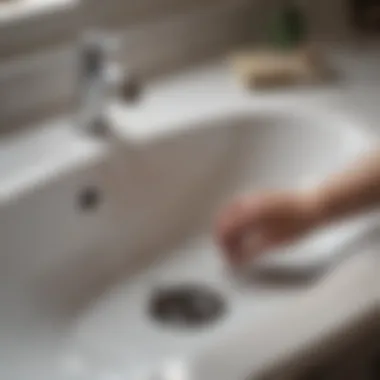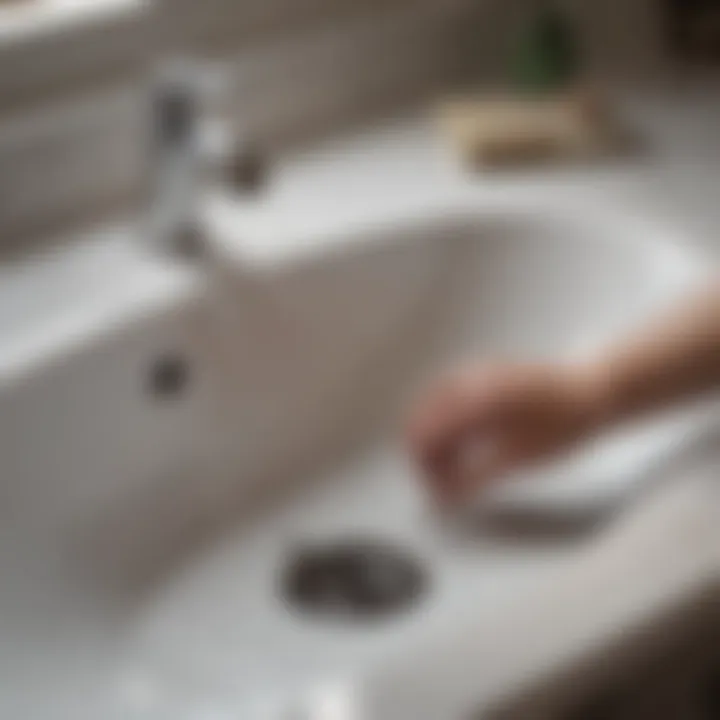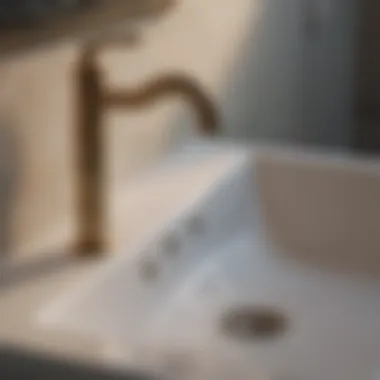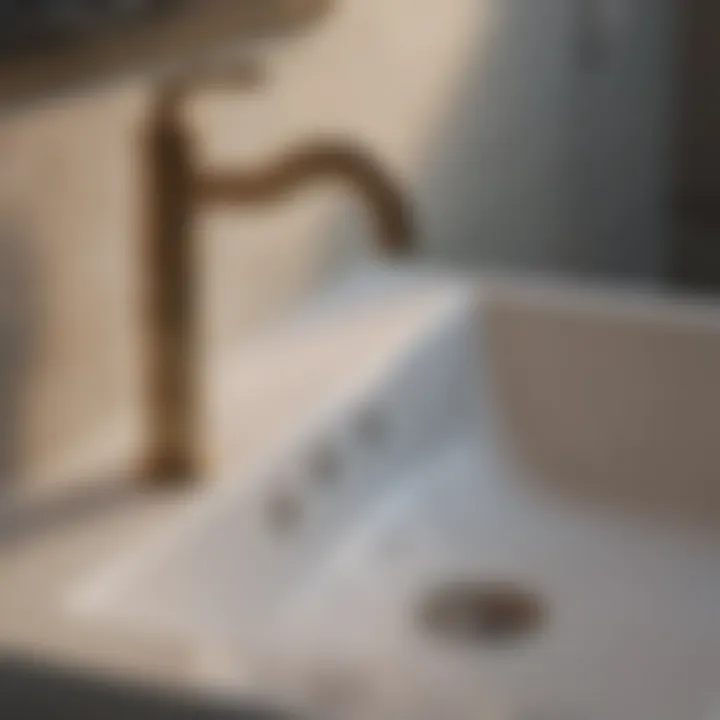Comprehensive Guide to Bathroom Sink Drain Assembly


Intro
When it comes to bathroom functionality, the drain assembly plays a crucial role. It ensures that water flows smoothly from the sink, preventing clogs and backups that can lead to more serious plumbing issues. Understanding the components of a drain assembly, as well as the installation and maintenance processes, is fundamental for homeowners and renters alike. This guide will provide a detailed look into the aspects of sink drain assemblies, empowering readers with knowledge to manage their bathroom sinks effectively.
Design Inspirations
Trending Styles
The design of bathroom sinks has evolved significantly in recent years. Modern styles lean towards minimalism, featuring sleek lines and understated elegance. Those interested in a more traditional feel might gravitate towards porcelain sinks with intricate detailing. Another popular approach is to use vessel sinks, which sit above the counter, adding dimension and visual interest to the space.
Color Palettes
While traditional white sinks remain a popular choice, color trends are shifting toward softer hues and bold statements. Shades like pastel blue or even muted greens can create a calming effect. For a more dramatic look, one might consider matte black or deep navy. This variation in color can make a significant difference in the overall aesthetic of the bathroom.
Components of Drain Assembly
The drain assembly consists of several critical parts:
- Pop-up Drain: Allows for easy operation of the sink and features a stopper to prevent water from draining when needed.
- Tailpiece: The tube that connects the pop-up drain to the P-trap, forming an integral connection.
- P-trap: This U-shaped pipe prevents sewer gases from entering the home while allowing wastewater to flow out.
Familiarity with these components is essential for effective installation and maintenance.
Installation Process
Installing a drain assembly can be a manageable DIY project. Start with the following steps:
- Gather Tools: Ensure you have a wrench, plumber's tape, and a silicone sealant on hand.
- Remove Old Assembly: If replacing, carefully detach the previous assembly from both the sink and the drainpipe.
- Install the Pop-up Drain: Follow manufacturer’s instructions to attach the pop-up assembly securely.
- Attach the Tailpiece: Connect the tailpiece to the pop-up drain.
- Install the P-trap: Finally, connect the P-trap to the tailpiece and the wall drain.
Be sure to check for leaks after the installation.
Maintenance Tips
Regular maintenance can prolong the life of your drain assembly. Here are a few practical tips:
- Clear Debris Regularly: Use a drain snake or similar tool to remove buildup.
- Check for Leaks: Inspect connections periodically to ensure tight seals.
- Clean with Care: Avoid harsh chemicals that can damage plumbing.
"Prevention is always easier than repair when it comes to plumbing systems."
Troubleshooting Methods
Even with proper installation and maintenance, issues may arise. Common problems include clogs and leaks. Here’s how to address them:
- For clogs, try using a plunger first. If that doesn't work, a drain snake can be effective.
- For leaks, identify the source and tighten connections as needed or replace seals if worn.
End
Understanding the components and functions of the drain assembly for your bathroom sink enhances your ability to maintain it. This knowledge leads to fewer plumbing issues and contributes to an efficient bathroom overall. By applying the tips mentioned in this guide, homeowners can ensure their sinks remain a reliable part of their daily routine.
Understanding Drain Assemblies
Understanding drain assemblies is critical for anyone looking to maintain or install a bathroom sink without overwhelming themselves. A drain assembly plays a vital role in proper waste removal and is essential for a functional bathroom.
Definition and Purpose
The drain assembly consists of various components working together to carry wastewater away from the sink. At its core, it includes parts like the drain body, drain flange, and P-trap, which help create a seal and prevent odors from escaping into the bathroom. The drain flange, for instance, is installed at the sink and provides a secure connection to the drain body.
Beyond just removal of water, drain assemblies are designed to handle a variety of tasks. They prevent clogs and backflow, ensuring that bathroom usage remains efficient and seamless. Maintaining proper water flow through an effective drain assembly also helps prevent damage to other plumbing fixtures in the house, as a well-functioning drain assembly addresses issues proactively.


Importance of a Well-Functioning Drain
A well-functioning drain assembly is vital to any bathroom's overall performance. Here are key reasons why it matters:
- Prevent Odors: A strong assembly prevents unpleasant smells by ensuring waste materials are correctly transported and sealed.
- Avoid Clogs: Regular use and the nature of bathroom activities make the drain susceptible to blockages. An efficient assembly minimizes this risk.
- Support Maintenance: A reliable drain assembly simplifies cleaning and repairs, saving time and reducing potential costs associated with serious plumbing issues.
In summary, understanding the components and purpose of drain assemblies equips homeowners with the knowledge to tackle installation or maintenance tasks effectively. The insights gained from this section lay a strong foundation for appreciating the detailed elements of drain assemblies that will follow.
Key Components of Drain Assembly
Understanding the key components of the drain assembly is essential for both effective installation and maintenance. Each part serves a specific purpose, ensuring that wastewater is properly diverted and that the system functions smoothly. Knowing what these components are, how they work together, and the materials they are made from can enhance a homeowner's ability to troubleshoot and maintain their bathroom sink.
Drain Body
The drain body, often made of metal or plastic, forms the primary structure of the drain assembly. It contains the opening through which wastewater flows out of the sink. The diameter and design of the drain body can vary, which is important to consider when selecting a sink or replacing an old assembly. A wider drain body typically allows for better flow, reducing the chances of clogs over time. Additionally, ensure that the finish matches other fixtures in the bathroom to maintain aesthetics.
Drain Flange
The drain flange sits on top of the sink, providing a finished look while creating a seal against leaks. It plays a critical role in generating a tight connection between the sink and drain body. The flange is often secured with screws, which need to be tightened to prevent any gaps. A securely positioned drain flange minimizes the risk of water leaking and causing damage to the cabinet beneath the sink.
P-Trap
The P-trap is a curved section of pipe that holds water to prevent sewer gases from entering the bathroom. Its distinctive shape makes this component vital for maintaining air quality in your home. The water in the P-trap acts as a seal, effectively blocking any unpleasant odors from traveling back up through the drain. Regular inspection is necessary, as buildup in the trap can lead to slow drainage and potential clogs.
Tailpiece
The tailpiece is the pipe that connects the drain body to the P-trap. This vertical pipe ensures a smooth transition of wastewater from the sink to the drain system. Tailpieces typically come in a variety of lengths and diameters, allowing for flexibility in installations. An improper fit can cause leaks, so ensure the measurements are right before purchasing.
Overflow Mechanism
The overflow mechanism is an often-overlooked component, but it plays a crucial role in preventing overflows when the sink is filled too high. It is a small opening near the top of the sink that connects to a pipe leading down to the drain body. In the event that the sink exceeds its capacity, the excess water flows through this mechanism, preventing spillage onto the floor. Keeping this area clear from blockages is important for its effective operation.
Washers and Gaskets
Washers and gaskets create a seal at various connection points in the drain assembly. They prevent leaks and ensure that each component fits snugly against one another. It is important to choose the right material, as rubber or silicone washers tend to provide better resilience against aging and wear. Regularly checking and replacing worn washers will contribute to a leak-free sink.
A well-designed drain assembly can minimize both maintenance issues and plumbing emergencies, ensuring that your bathroom functions effectively.
Understanding these key components not only facilitates the installation process but also enhances overall awareness of how a bathroom sink operates. Being informed about the parts and their functions leads to better maintenance and longevity of your sink's plumbing system.
Tools Required for Installation
When undertaking the installation of a drain assembly, having the right tools is crucial. The importance of this section cannot be overstated. Tools are not just items to have; they enable efficiency, accuracy, and safety during the installation process. By using appropriate tools, one can minimize mistakes and ensure the longevity of the drain assembly. Moreover, being equipped with the right tools reduces the likelihood of a costly repair or replacement down the line. Thus, understanding which tools are necessary is vital for anyone looking to improve their bathroom setup.
Basic Hand Tools
Basic hand tools are the foundation of any plumbing task. For drain assembly installation, common tools include screwdrivers, pliers, and adjustable wrenches. Each tool has a specific purpose. For instance, screwdrivers help secure the drain flange while pliers allow you to grip various fittings tightly. Here are some crucial hand tools together with their uses:
- Screwdriver: Essential for tightening screws within the drain flange.
- Pliers: Useful for grasping small components, especially when dealing with tight spaces.
- Adjustable Wrench: Handy when you need to secure or loosen nuts and fittings.
Plumbing Wrench
A plumbing wrench, often referred to as a basin wrench, is an important tool when dealing with drain assembly. Its unique design allows the user to access difficult-to-reach nuts and bolts beneath sinks. The long handle provides leverage, which is essential when tightening or loosening fittings. In any plumbing project, having a plumbing wrench at hand can expedite your work.
- Benefits include:
- Ability to reach tight spaces with ease.
- Adjustable jaw accommodates various sizes of fittings.
- Reduces the risk of damaging the fixtures due to over-tightening as it allows better grip and control.
Teflon Tape


Teflon tape is a small yet vital component in plumbing installation. It is used to create a watertight seal on threaded joints, preventing leaks. In the context of drain assembly, applying Teflon tape is important to ensure the longevity of the seals between significant parts like the tailpiece and P-trap.
- Usage tips for Teflon tape include:
- Wrap the tape around the threads in the same direction as the threads turn.
- Do not over-apply; a couple of layers are generally sufficient.
Installing a Drain Assembly
Installing a drain assembly is a crucial step in ensuring your bathroom sink operates optimally. A well-installed drain can significantly enhance the efficiency of your sink, reducing the risk of clogs and leaks. Understanding the components and proper methods for installation equips homeowners with the skills to handle this task. Whether you are replacing an old assembly or installing a new sink, mastering the installation process is cost-effective and a lifelong skill.
Preparing the Area
Before starting the installation, proper preparation is essential. Clear the area under the sink of any items like cleaning supplies or tools. This brightens the workspace and helps avoid clutter. Turn off the water supply to prevent any accidental spills. Have a bucket or towels nearby for cleanliness. Assess the existing plumbing setup to grasp how the new assembly will fit into the current configuration. Knowing how to manage the piping effectively eases the process later on.
Attaching the Drain Flange
The drain flange sits atop the sink and is the first link in your drain assembly. Begin by applying a plumber's putty around the flange. This putty acts as a sealant, preventing leaks. Insert the drain flange into the sink hole and press it down to ensure it adheres firmly. Below the sink, attach a washer and a nut to secure the flange in place. Tighten carefully; overtightening can cause damage. Once secured, wipe away any excess putty. This step establishes a solid foundation for the rest of the assembly.
Connecting the Tailpiece
The tailpiece connects directly to the drain flange and directs water into the P-trap. Measure the distance from the drain flange to the P-trap and cut the tailpiece to fit if necessary. Slide the tailpiece into the drain flange, ensuring a snug fit. Secure it in place by tightening the slip nut. This connection plays an integral role in preventing wastewater from backing up into the sink.
Installing the P-Trap
The P-trap is vital for preventing odors from entering your bathroom. Position the P-trap beneath the tailpiece. Match the alignment of the P-trap’s inlet with the outlet from the tailpiece. Use slip nuts to secure both ends of the P-trap, ensuring there is a tight fit without leaks. Ensure the assembly has a slight downward slope towards the drain that meets plumbing code requirements. This slope helps facilitate proper drainage and minimizes the risk of clogs.
Securing the Overflow Assembly
If your sink has an overflow function, it is crucial to connect the overflow assembly correctly. The overflow assembly links to the drain, allowing excess water to escape before it overflows the sink. Attach the overflow tube to the back of the sink, ensuring a secure connection. Tighten the nuts, but remain cautious not to overtighten. Verify that the overflow is clear of any blockages to maintain its functionality. A correctly installed overflow not only enhances safety but increases the lifespan of the sink.
Proper installation of all drain components ensures longevity and efficiency, minimizing future repairs.
Following these steps guarantees that your drain assembly is properly installed and functions as intended. By paying attention to detail, you enhance the functionality and reliability of your bathroom sink.
Common Issues with Drain Assemblies
Understanding the common issues that arise with drain assemblies is crucial for anyone dealing with bathroom sinks. A well-functioning drain system is essential for the overall performance of your bathroom. When issues occur, they may not only disrupt daily routines, but can also lead to more significant plumbing problems if not addressed promptly. This section will explore three prevalent issues: clogs, leaking connections, and slow drainage. Each of these will be examined to provide clarity on their causes, implications, and possible solutions.
Clogs
Clogs are perhaps the most frequent issue encountered in drain assemblies. They typically develop due to the accumulation of soap residue, hair, and other debris. This buildup can restrict water flow, resulting in standing water in the sink. When water does not flow freely, it can also create unpleasant odors due to stagnant water.
To alleviate this problem, regular maintenance is key. Homeowners should periodically inspect and clean their drains. Using a mixture of baking soda and vinegar can help dissolve buildup in the pipes. If clogs persist, a plumbing snake may be necessary to remove more stubborn obstructions. Recognizing the signs of a clog early can save time and money.
Leaking Connections
Leaking connections can lead to both water wastage and significant damage to the surrounding areas. These leaks often occur at joints and connections within the drain assembly, particularly where the tailpiece connects to the P-trap or where the drain flange joins the sink. If you notice water pooling under your sink or damp spots on the cabinet floor, a leak is likely.
To address leaks, first, check all the fittings for tightness. If any parts are loose, simply tightening them might resolve the issue. If the problem continues, inspect for worn or damaged washers or gaskets. Replacing these components is usually straightforward and can effectively stop leaks.
Slow Drainage
Slow drainage may indicate a more serious problem within the drain assembly. Several factors could cause this issue, including partial clogs, improper installation, or even venting issues. When water drains slowly, it can be frustrating and inconvenient.
To tackle slow drainage, start with the most accessible solution—cleaning the drain. If this does not help, check for kinks in the tailpiece or P-trap, as these can impede water flow. Additionally, verifying that the vent pipe is clear of obstructions is critical, as proper venting is necessary for efficient drainage.
Efficient functioning of a drain assembly can significantly improve the bathroom experience—preventing clogs, leaks, and slow drainage allows for smoother daily routines.
Maintenance of Drain Assemblies


Maintaining the drain assembly in your bathroom sink is crucial for ensuring efficient functionality and longevity. A well-maintained drain not only prevents common issues such as clogs and leaks but also promotes a healthier environment by minimizing the risk of unpleasant odors. Regular maintenance activities are relatively simple and can often be done without professional help. It is essential for homeowners and renters to understand the methods and benefits of maintaining their drain assemblies to avoid costly repairs down the road.
Regular Cleaning
Regular cleaning of your drain assembly is a fundamental aspect of maintenance. Over time, debris such as hair, soap residue, and minerals can accumulate in the drain system. This build-up can lead to blockages that affect water drainage. To ensure your drain remains clear, it is advisable to perform cleaning every few weeks. Using a simple mixture of baking soda and vinegar can be effective. Pour the baking soda down the drain followed by vinegar. The reaction helps dissolve buildups.
Here are some steps for effective cleaning:
- Flush with hot water: Start by running hot water through the drain for a few minutes to loosen any residue.
- Apply cleaning solution: Follow up with your baking soda and vinegar mixture. Allow it to sit for about 30 minutes.
- Rinse: Finally, flush the drain with hot water again to wash away the debris.
Inspecting Seals and Joints
Regular inspections of seals and joints are vital for preventing leaks. The main entry points for potential leakage are often at connections between the drain assembly components. Check for any signs of wear or damage around these areas.
Consider the following when inspecting seals and joints:
- Visual checks: Look for any visible cracks or deterioration on the seals.
- Tighten connections: Ensure that all the nuts and bolts are securely fastened. Loose connections can lead to leaks.
- Replacement: If any seals appear damaged, they should be replaced promptly to maintain the integrity of the drain assembly.
Keeping an eye on these small details can save considerable cost and hassle later on.
Using Drain Covers
Using drain covers is a simple yet effective way to enhance your drain assembly’s maintenance. Drain covers act as barriers, capturing debris before it enters the drain system. This can significantly reduce the frequency of clogs. Look for covers that fit securely within your sink drain and are easy to remove for cleaning.
Consider these benefits of using drain covers:
- Prevention of blockages: By trapping hair and other debris, drain covers minimize the chances of blockages.
- Enhanced hygiene: Covers help in maintaining hygiene by keeping unwanted debris out of your drain.
- Aesthetic options: Available in various styles and materials, they can complement your bathroom decor while serving a practical function.
In summary, paying attention to the maintenance of drain assemblies is essential for every homeowner or renter. Regular cleaning, inspecting seals and joints, and using drain covers are meaningful steps that enhance the durability and functionality of your bathroom sink drainage system. By proactively addressing these aspects, you can prevent common drainage issues and ensure a smoothly functioning bathroom.
Upgrading Your Drain Assembly
Upgrading your drain assembly can significantly improve the functionality and aesthetics of your bathroom sink. Old or outdated drain systems often lead to a range of issues such as leaks, poor drainage, and even unpleasant odors. Thus, modernizing the components of your drain assembly can offer several advantages, from increased durability to enhanced efficiency.
Choosing Modern Materials
When considering an upgrade, it is crucial to select modern materials that not only enhance performance but also extend the lifespan of the assembly. For instance, materials such as stainless steel or high-quality plastic are preferable over traditional metal components.
- Stainless Steel: Known for its resistance to corrosion and stains, stainless steel provides both durability and aesthetic appeal. It is less likely to develop leaks over time.
- PVC and ABS Plastic: These plastics are lightweight, cost-effective, and do not corrode. They are also easy to install, making them ideal for DIY enthusiasts.
Using modern materials may slightly increase the initial cost, but the long-term benefits are worthwhile. Improved resistance to wear and tear reduces the need for frequent replacements, ultimately saving you money and effort over time.
Incorporating Eco-Friendly Options
In contemporary home improvement, eco-friendliness is paramount. Incorporating eco-friendly options in your drain assembly can lead to significant environmental benefits.
- Low-Flow Features: Upgrading to low-flow fixtures reduces water usage while maintaining adequate flow, contributing to water conservation efforts.
- Recycled Materials: Choose drain components made from recycled materials that meet or exceed modern standards for durability.
- Non-Toxic Sealants: Utilize sealants and adhesives that are free from harmful chemicals. These products help ensure a healthier indoor environment.
By considering these eco-friendly options, you not only contribute to sustainability but also improve the overall efficiency of your drainage system. In addition, many modern products are designed with ease of installation in mind.
Upgrading your drain assembly is not just a matter of choice, but an investment in quality and environmental responsibility.
In summary, upgrading your drain assembly involves careful consideration of materials and eco-friendly options. The selection of modern components enhances functionality and promotes sustainability in your home.
Closure
In any discussion about bathroom sink drain assemblies, the conclusion serves as a vital recap of the key themes throughout the article. Understanding the intricacies of drain assembly is not just a matter of installation; it encompasses the significance of proper maintenance and troubleshooting various issues that may arise. A well-functioning drain assembly directly affects the functionality of the bathroom, impacting both daily use and long-term satisfaction.
Summary of Key Points
- The drain assembly consists of multiple components, each playing a crucial role in effective drainage.
- Installation requires careful preparations and knowledge of the space to avoid future issues.
- Common problems like clogs and leaks can disrupt the overall efficacy of the sink, making regular maintenance essential.
- Upgrading materials can lead to better performance and eco-friendliness in managing bathroom waste.
Final Thoughts
Understanding the complete makeup of drain assemblies empowers homeowners. This knowledge allows for informed decisions, whether it is through maintenance or upgrades. Ignoring the drain assembly might lead to a compromised bathroom experience. Instead, recognizing the importance of each component fosters an environment where functionality reigns. With proper care and understanding, the assembly can serve effectively for many years, enhancing the integrity and usability of the bathroom space. Remember, a well-maintained drain assembly is foundational to a seamless bathroom experience.



